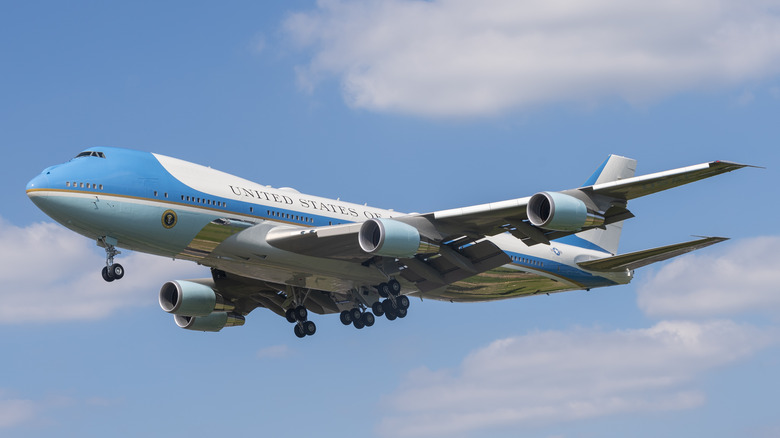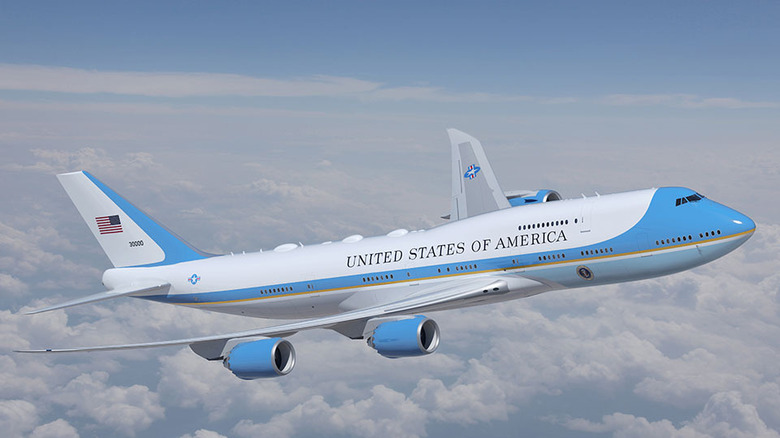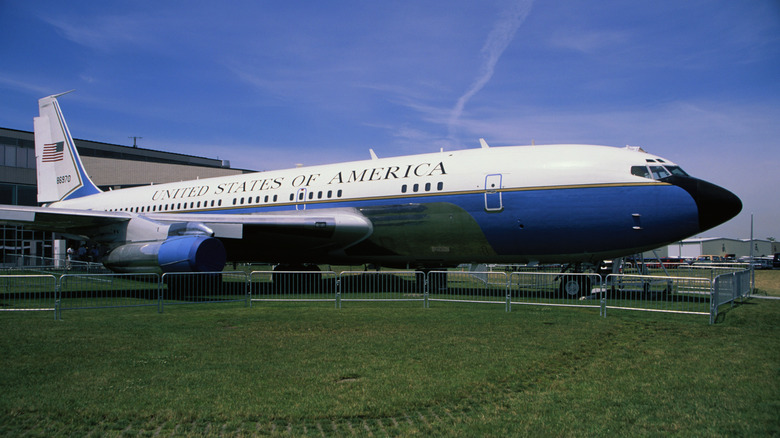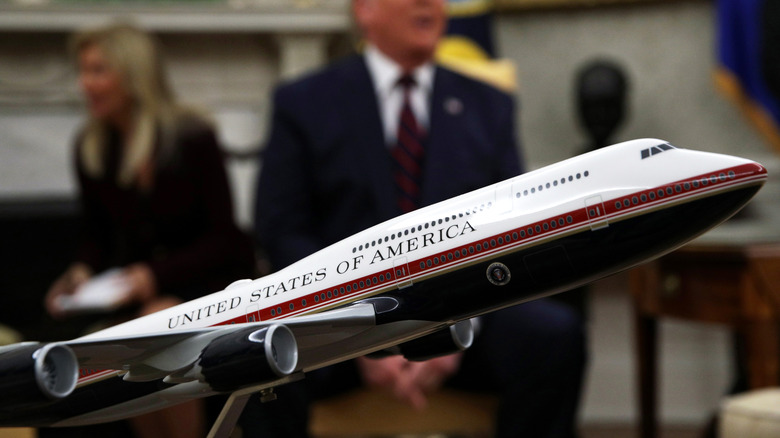Why Did The USAF Choose Boeing 747-8 Jet To Replace The Current Air Force One?
Boeing has a long history with the office of the president of the United States, being the designated manufacturer of Air Force One for 66 years. Side note: Air Force One is merely the radio call sign the Air Force uses when the president of the United States is onboard any Air Force aircraft. They could be in the cockpit of a fifth generation aircraft like the F-22 Raptor and it would receive the name Air Force One over the radio.
The president, starting with George H.W. Bush, has been flying aboard a Boeing 747-200 — Air Force designation VC-25A — since 1987, but that's going to change by 2027. Despite the Boeing 747 being discontinued, the next official plane of the president will be an updated 747 design. While initially projected to be delivered to the president by 2024, the new Boeing 747-8 — Air Force designation VC-25B — won't fly a president until just before the 2028 presidential election. Keeping with tradition, there will be two identical 747s for the president, with the second being delivered in 2028.
Boeing hasn't been the only airline manufacturer of the prolific Air Force One, but the first plane a president flew on was a Boeing. The company has been the contracted manufacturer of the "President's office in the sky" since 1958 with a B707. Additionally, former President Donald J. Trump struck a favorable deal with Boeing to design the new Air Force One.
747-8 compared to the old 747-200
The current 747-200B, serving as the president's ride in the sky, is capable of much more than the commercial 747. While passenger airlines refuel on the ground, the president's plane can refuel midair for those extra long flights where delays aren't a possibility. As many can surmise from Hollywood movies or public photos, Air Force One's layout isn't remotely similar to a passenger plane. It has conference rooms, a separate bedroom for the president along with an office, separate office space for staff, a medical facility, and so much more.
The president's current 747 can fly 6,735 nautical miles without refueling. For perspective, that's equivalent to a flight from Washington D.C. to Tokyo, Japan. Meanwhile, the new 747-8 will be able to travel an additional 1,000 nautical miles without topping off on fuel, which would get it from D.C. to Hong Kong. Additionally, the new 747 will be the fastest commercial jet in the world, with a cruising speed of Mach .855. The exact engines it will use is unknown, but the commercial model comes with four General Electric GEnx-2B engines.
It's predecessor? Mach .84 with four General Electric CF6-80C2B1 engines. The 747-8 will also have the record of being the longest commercial aircraft in the world with a length of 250 feet and two inches, whereas the 747-200 was 18 feet and four inches shorter. Despite its larger size, the new 747-8 will produce 16 fewer tons of carbon dioxide emissions.
History of presidential aircrafts
There wasn't always an Air Force One. Obviously, the first several presidents existed long before the first airplane was ever invented. Even when commercial flight became more ordinary, the more common mode of transportation was by train or boat. Franklin D. Roosevelt was the first president to fly in 1943 aboard a Boeing 314, the "Dixie Clipper." After that, Douglas was contracted, and it modified a DC-4 for FDR that Harry Truman eventually flew on, too. Douglas went on to create the DC-6 Liftmaster, which would be modified in 1947 to fit the president's needs. At this time, the term Air Force One hadn't been used to describe the president's plane.
That term came about after a communication mix-up in 1953 between air traffic control, the presidential plane, and an Eastern Airlines flight with the same flight and tail number as the president's plane. Designating the plane with the president as Air Force One prevented any further mistaken identities. The DC-6 was also the last prop plane used by the president, because the leader of the free world should be up-to-date with all technology. In 1959, Boeing delivered the first jetliner to the White House — the B707, designated VC-137A. Boeing followed this version up with VC-137C, which stayed in service from 1962 to 1990.
1990 saw President George H.W. Bush and every subsequent president fly on the Boeing 747-200 — or VC-25A — that most recognize as the Air Force One aircraft today.
The paint drama and Boeing's financial woes
Dave Calhoun, Boeing's CEO, revealed in 2022 that the company lost $1.1 billion after striking a deal with former President Donald Trump. What the company and former CEO, Dennis Muilenburg, touted as a good deal in 2018 turned out to be a waste of funds in the end. As part of the 2018 deal, the former president had the opportunity to pick a new color scheme for the next-generation 747. His idea called for a red, white, and blue pattern, getting rid of the traditional baby blue color scheme America is familiar with. He not only wanted a dark shade of blue, but he called for the entire underbelly of the plane to be blanketed in this new shade of blue.
The plane was supposed to be delivered in 2024, but there were delays and extra costs because of the former president's design. The dark blue underbelly would have required a significant redesign of the craft, otherwise, it would overheat electronics found at the bottom of the aircraft. If the paint job was approved, everything would have needed to be rearranged.
In order to conduct further tests and receive certification, current President Biden had the honor of finalizing the color scheme. He opted for two light shades of blue, reminiscent of the traditional paint job seen on the plane that's been around since John F. Kennedy's administration. While the former president's idea wasn't bad looking, it came with "a very unique set of risks."



